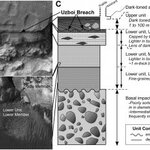Geology

New geological evidence radiometric dating indicates the Grand Canyon may be so old that dinosaurs once lumbered along its rim, pushing back its assumed origins by 40 million to 50 million years.
The researchers from the University of Colorado at Boulder and the California Institute of Technology gathered evidence from rocks in the canyon and on surrounding plateaus that were deposited near sea level several hundred million years ago before the region uplifted and eroded to form the canyon.
"As rocks moved to the surface in the Grand Canyon region, they cooled off," said CU-Boulder geological…

New research suggests that the geological staying power of continents comes partly from their losing battle with the Earth's oceans over magnesium. The research finds continents lose more than 20 percent of their initial mass via chemical reactions involving the Earth's crust, water and atmosphere. Because much of the lost mass is dominated by magnesium and calcium, continents ultimately gain because the lighter, silicon-rich rock that's left behind is buoyed up by denser rock beneath the Earth's crust.
The Earth's continents seem like fixtures, having changed little throughout recorded human…

Scientists analysing the data from the European Venus Express spacecraft now orbiting Earth's prodigal twin planet have been piecing together an understanding of why the climate on both worlds is so different. Professor Fred Taylor of Oxford University presented the scenario in a talk at the RAS National Astronomy Meeting in Belfast on Wednesday 2nd April.
In the early stages of the Solar System, Venus seems to have evolved very rapidly compared to the Earth. Data from Venus Express supports the theory that the Earth’s twin once had significant volume of water covering the surface but it…

For the first time scientists have mapped the layers of once molten rock that lie beneath the edges of the Atlantic Ocean and measure over eight miles thick in some locations.
The research gives us a better understanding of what may have happened during the break up of continents to form new mid-ocean ridges. The same volcanic activity in the North Atlantic may also have caused the subsequent release of massive volumes of greenhouse gases which led to a spike in global temperatures 55 million years ago.
The scientists, led by Professor Robert White, FRS at the University of Cambridge, also…

On Sept. 15, 2007, an object hurtled through the sky and crashed near the village of Carancas in Peru. Scientists dispatched to the site found a gaping hole in the ground.
Peter Schultz, professor of geological sciences at Brown University and an expert in extraterrestrial impacts, went to Peru to learn more and he presented the findings from his travels at the 39th annual Lunar and Planetary Science Conference in League City, Texas.
What Schultz and his team revealed: The object that slammed into a dry riverbed in Peru was a meteorite, and it left a 49-foot-wide crater. Soil ejected from…

Geologists at the University of Illinois have confirmed the discovery of Earth’s inner, innermost core, and have created a three-dimensional model that describes the seismic anisotropy and texturing of iron crystals within the inner core.
“For many years, we have been like blind men touching different parts of an elephant,” said U. of I. geologist Xiaodong Song. “Now, for the fist time, we have a sense of the entire elephant, and see what the inner core of Earth really looks like.”
Using both newly acquired data and legacy data collected around the world, Song and postdoctoral research…

In Vadose Zone Journal, researchers state that a much smaller spatial resolution should be used for modeling soil water.
Soils are complicated porous media that are highly relevant for the sustainable use of water resources. Not only the essential basis for agriculture, soils also act as a filter for clean drinking water, and, depending on soil properties, they dampen or intensify surface runoff and thus susceptibility to floods. Moreover, the interaction of soil water with the atmosphere and the related energy flux is an important part of modern weather and climate models.
An accurate…

Scientists studying images from The High Resolution Imaging Experiment camera on NASA's Mars Reconnaissance Orbiter have discovered never-before-seen impact "megabreccia" and a possibly once-habitable ancient lake on Mars at a place called Holden crater.
The megabreccia is topped by layers of fine sediments that formed in what apparently was a long-lived, calm lake that filled Holden crater on early Mars, HiRISE scientists say.
"Holden crater has some of the best-exposed lake deposits and ancient megabreccia known on Mars," said HiRISE's principal investigator, professor Alfred McEwen of the…

The Queen Charlotte Islands are at the western edge of the continental shelf and form part of Wrangellia, an exotic terrane of former island arcs, which also includes Vancouver Island, parts of western mainland British Columbia and southern Alaska. While we’ll see that there are two competing schools of thought on Wrangellia’s more recent history, both sides agree that many of the rocks, and the fossils they contain, were laid down somewhere near the equator.
They had a long, arduous journey, first being pushed by advancing plates, then being uplifted, intruded, folded, and finally thrust up…

The discovery of three-billion-year-old zircon microcrystals in northern Ontario by an international research team is providing a new record of the processes that form continents and their natural resources, including gold and diamonds.
Measuring no more than the width of a human hair, the 200-million-year growth span of these ancient microcrystals is longer than any previously discovered.
The findings provide a new record of planetary evolution and contradict previous experimental predictions that the crystals would change when exposed to heat and pressure upon burial in the deep Earth.…